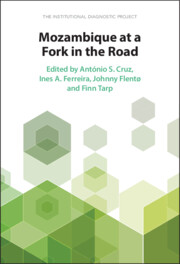Book contents
- Mozambique at a Fork in the Road
- Institutional Diagnostic Project
- Additional material
- Mozambique at a Fork in the Road
- Copyright page
- Contents
- Figures
- Tables
- Notes on Contributors
- Foreword
- Preface
- Acknowledgements
- Abbreviations
- Part I General Approach to the Diagnostic
- Part II Thematic Papers
- Part III Synthesis
- References
- Index
- References
References
Published online by Cambridge University Press: 14 December 2023
- Mozambique at a Fork in the Road
- Institutional Diagnostic Project
- Additional material
- Mozambique at a Fork in the Road
- Copyright page
- Contents
- Figures
- Tables
- Notes on Contributors
- Foreword
- Preface
- Acknowledgements
- Abbreviations
- Part I General Approach to the Diagnostic
- Part II Thematic Papers
- Part III Synthesis
- References
- Index
- References
Summary
- Type
- Chapter
- Information
- Mozambique at a Fork in the RoadThe Institutional Diagnostic Project, pp. 351 - 384Publisher: Cambridge University PressPrint publication year: 2023
- Creative Commons
- This content is Open Access and distributed under the terms of the Creative Commons Attribution licence CC-BY-NC-SA 4.0 https://creativecommons.org/cclicenses/

